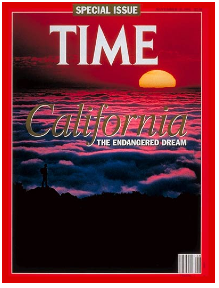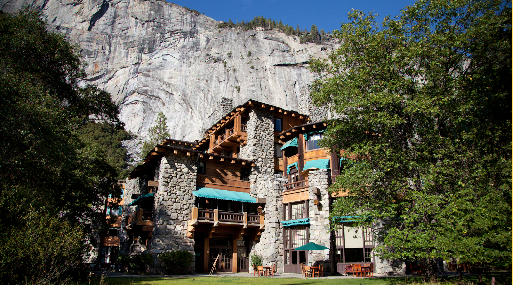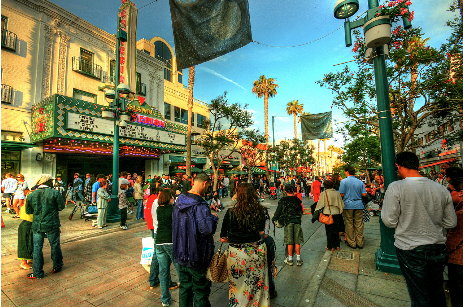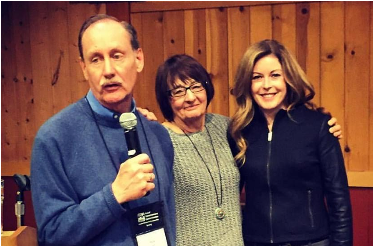This special Livable Places Update was adapted from Rick Cole’s keynote at this year’s Ahwahnee Conference for Local Elected Officials
Rediscovering the California Dream: A 25-Year Reflection on the Ahwahnee Principles
Nothing is more powerful than an idea whose time has come.
– Victor Hugo
This special Livable Places Update was adapted from Rick Cole’s keynote at this year’s Ahwahnee Conference for Local Elected Officials.

To understand how far we’ve come over the last 25 years and the significance of the Ahwahnee Principles, it’s helpful to set the scene and go back to 1991.
Back in 1991, when the Ahwahnee Principles were developed and the first conference took place, California had a population of 30 million. There was a tremendous backlash against the impact of suburban sprawl— 512,000 people left the state that year and Time magazine said, “those escapees are being driven away by an accelerating decrease in quality of life: clogged freeways, eye-stinging smog, despoiled landscapes, polluted beaches, water shortages, unaffordable housing, and beleaguered industry.”
We were in the middle of a post-Cold War recession with California losing some of its signature businesses and suffering huge aerospace lay-offs. We were also in the midst of the worst drought since the Great Depression with $1 billion in crop losses. The dust storms in the Central Valley were bad enough to cause fatal freeway pile-ups. There were extensive wildfires, floods and the earthquake in SoCal.
In that California setting, LGC Founder Judy Corbett invited a small number of architects to her home in Davis to talk about principles that would be a foundation for a renewal of the California dream. Out of that conversation came the Principles for Resource Efficient Communities – later known as the Ahwahnee Principles.
In 1991, in the world of suburban sprawl, this land of eye-stinging smog and despoiled landscapes, the Ahwahnee Principles marked a transformational break with the status quo. Looking back today, they seem like common sense. But 25 years ago, they were revolutionary.
The Ahwahnee Principles were then presented to local elected officials. Why? Because the Local Government Commission had found that local officials are catalysts. They are practical visionaries. They get up in the morning and build coalitions and get things done. They win votes, implement policies, build models, and then talk about them with other leaders.
The first Ahwahnee Conference brought together almost 100 elected officials, mostly from the LGC network of environmentally progressive elected officials, who were dubious and skeptical of anything resembling new growth. What they were seeing was not smart growth, it was clearly dumb growth. That sprawl approach had turned away from timeless principles of building with the climate, conserving energy, using local materials.

Victor Hugo said, “Nothing is more powerful than an idea whose time has come.” The endangered California dream needed renewal, and the Ahwahnee Principles for Resource Efficient Communities was that revolutionary opening to a better and more sustainable future for California and beyond.
I couldn’t wait to go home, to try these new ideas in Pasadena. The challenge was tremendous. In Pasadena, the growth forces and the anti-growth forces were at each other’s throats. We were under court order to completely rewrite Pasadena’s General Plan within 18 months and take it to the voters for approval. By embracing the Ahwahnee Principles, the new plan got 58% of the vote.
The Ahwahnee Principles’ powerful new vision for “complete and integrated communities” was the antidote to sprawl. The Ahwahnee Principles also issued a challenge to the public sector: rather than allowing developer-initiated piecemeal development, local governments were charged with taking over the planning process, creating plans in an open process and involving the community in planning for their future.
A Hard Road to Smart Growth
This was an extraordinary paradigm shift that threatened existing processes and interests.
Planners were against us. They had been imbued in a suburban zoning code model, don’t mix uses! Not only that, but don’t mix people!
Comfortable with modernist theory, architects were against it: Let’s build everything new, with new materials, with neo-brutalist towers around parking lots.
Developers were against it. They were making money building suburban sprawl. Elected officials were pretty happy with the status quo – and the campaign contributions.
Environmentalists were against it. They didn’t want more buildings and traffic.
Civil-rights activists were dubious. This doesn’t apply to the jobs we need in our community.
The transportation industry was happy spending billions of dollars in concrete, widening freeways.
Suburbanites were against it. The suburbs were great for them as long as their subdivision was the last one and they could look out at the green space behind them.
It was an implacable wall of hostility. But we were determined, and at the heart of it was the leadership of the Local Government Commission.
The Vision Realized: Acting Locally, Going National

In Santa Monica, a group of remarkable people created a different approach in that seaside town with the Third Street Promenade. In Brea, in Orange County, they built a brand new downtown with affordable housing built into it. Change spread in places like Lodi, and even in little Loomis – and not just at the local level, but also the regional level.
These people were entrepreneurs, pioneers, the start-up of a movement, creating models that you could replicate in your own community.
Making a difference one community at a time, they created new plans, new projects, new political alignments, new best practices, new policies and new breakthroughs – across a wide spectrum of community types and sizes throughout California.
In partnership with the EPA, the Local Government Commission and the Ahwahnee Principles put a spotlight on what California was doing, and LGC became a national center for distributing ideas and for importing ideas, from learning what was happening around the country. The New Partners for Smart Growth conference, now entering its 16th year, helped facilitate the conversation.
California has developed a remarkable and robust set of tools that no other state has. The implementation of the Ahwahnee Principles is now built into city and county General Plans across the state. Petaluma pioneered form-based codes.
We have dramatically expanded our rail transit networks in the Bay Area, Sacramento, San Diego and Los Angeles.
We know how to do downtown and neighborhood revitalizations, safe routes to school, and bike lanes. We have a remarkably advanced set of tools for transit-oriented development. Cities, counties and local nonprofits have pioneered climate action, and are making commitments to inclusionary affordable housing. Even parking reform is happening.
We’re now on the cutting edge of new approaches that will further sharpen our tools that could work in any community. We’re thinking about green streets that could absorb stormwater, complete streets shared by pedestrians, bicyclists, transit and the automobile – and ultimately for autonomous vehicles. We’re also thinking about Great Streets, streets that have economic and cultural vitality.
Our Vision Moving Forward
The Ahwahnee conference is a remarkable thing that started with 100 people – who over the last 25 years have influenced a state of 40 million people in a profound way. Our charge is to think about the next 25 years, and the role we will play in transforming California.
The leadership of the Local Government Commission has continued and grown in recent years and is well positioned to take on the challenges of the next quarter of a century.
As we enter into a new era of growing risk and uncertainty caused by climate change, the LGC has become one of the state’s preeminent voices for California’s leadership on climate change mitigation and adaptation.

We continue our commitment to reducing state and local regulatory barriers and assisting communities with real, proactive planning to make great places, to revitalize the urban planning professional – not to do paperwork or process development applications and zoning codes, but to do real planning for the future.
We recognize that we must deal with affordability, gentrification and displacement. It’s central to addressing the issues of our age – social and economic inequality.
The LGC is committed to creating a movement that inspires, compels and empowers the next generation of leaders to find solutions to create equitable, healthy communities. We recognize that the movement of the next 25 years will need to look like California, will need to involve young leaders and bring in the people who can benefit most from livable communities – those who suffer from asthma or heart disease exacerbated by our land-use decisions, can’t afford housing, or are impacted by job losses in their community.
We need to enlist these folks in the movement to make it a broad movement, a powerful majority. Because all lives matter, but also the neighborhoods where people live matter.
Together, we have an extraordinary opportunity to build this movement for the next quarter-century. We are climbing up the side of the mountain but we are not at the top.
The California Dream has always been endangered, because it is fragile. There was a lot in the 1990’s that needed fixing, there is a lot in 2016 that needs fixing.
We are the ones to do it!
If not us, who? If not now, when?
You can watch Rick’s full speech here:
Rick Cole is currently city manager of Santa Monica. He previously served as deputy mayor of Los Angeles, mayor of Pasadena and city manager for Azusa and Ventura.
Local Government Commission Newsletters
Livable Places Update
CURRENTS Newsletter
CivicSpark™ Newsletter
LGC Newsletters
Keep up to date with LGC’s newsletters!
Livable Places Update – April
April’s article: Microtransit: Right-Sizing Transportation to Improve Community Mobility
Currents: Spring 2019
Currents provides readers with current information on energy issues affecting local governments in California.
CivicSpark Newsletter – March
This monthly CivicSpark newsletter features updates on CivicSpark projects and highlights.



